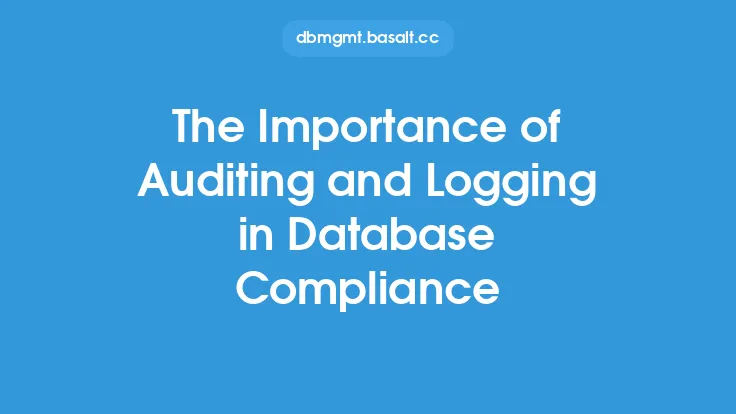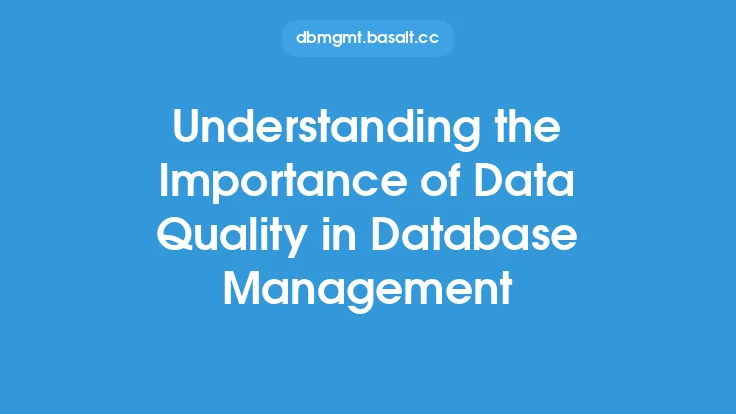Monitoring is a critical component of database capacity planning, as it provides the necessary insights to ensure that the database is operating efficiently and effectively. Without proper monitoring, it can be challenging to identify potential issues before they become major problems, leading to downtime, data loss, and other negative consequences. In this article, we will explore the importance of monitoring in database capacity planning, including the benefits, key metrics to track, and best practices for implementation.
Introduction to Monitoring in Database Capacity Planning
Monitoring in database capacity planning involves tracking various performance metrics to identify trends, patterns, and potential issues. This information is used to optimize database resources, improve performance, and ensure that the database is scalable and able to handle growing workloads. Effective monitoring requires a combination of tools, techniques, and expertise, as well as a deep understanding of the database and its underlying infrastructure.
Benefits of Monitoring in Database Capacity Planning
There are several benefits to monitoring in database capacity planning, including:
- Improved performance: Monitoring helps identify performance bottlenecks and areas for optimization, ensuring that the database is running at peak efficiency.
- Increased uptime: By identifying potential issues before they become major problems, monitoring helps minimize downtime and ensure that the database is always available.
- Better resource utilization: Monitoring helps optimize resource allocation, ensuring that the database is using the right amount of resources (e.g., CPU, memory, storage) to handle the workload.
- Enhanced scalability: Monitoring helps identify areas where the database may need to be scaled up or out, ensuring that it can handle growing workloads and increasing demand.
- Reduced costs: By optimizing resource utilization and minimizing downtime, monitoring can help reduce costs associated with database maintenance and operation.
Key Metrics to Track in Database Capacity Planning
There are several key metrics to track in database capacity planning, including:
- CPU utilization: Tracks the amount of CPU resources being used by the database, helping identify potential performance bottlenecks.
- Memory usage: Tracks the amount of memory being used by the database, helping identify potential issues with memory allocation and utilization.
- Storage usage: Tracks the amount of storage being used by the database, helping identify potential issues with storage capacity and utilization.
- Network usage: Tracks the amount of network resources being used by the database, helping identify potential issues with network bandwidth and latency.
- Query performance: Tracks the performance of database queries, helping identify potential issues with query optimization and execution.
Best Practices for Monitoring in Database Capacity Planning
There are several best practices for monitoring in database capacity planning, including:
- Use a combination of tools and techniques: Utilize a range of monitoring tools and techniques, including built-in database tools, third-party monitoring software, and custom scripts.
- Monitor at multiple levels: Monitor the database at multiple levels, including the instance level, database level, and table level.
- Set thresholds and alerts: Set thresholds and alerts for key metrics, ensuring that potential issues are identified and addressed promptly.
- Analyze trends and patterns: Analyze trends and patterns in monitoring data, helping identify potential issues and areas for optimization.
- Continuously review and refine: Continuously review and refine monitoring strategies, ensuring that they remain effective and aligned with changing database needs.
Technical Considerations for Monitoring in Database Capacity Planning
There are several technical considerations for monitoring in database capacity planning, including:
- Data collection: Ensure that monitoring data is collected regularly and consistently, using a range of methods (e.g., polling, logging, tracing).
- Data storage: Ensure that monitoring data is stored securely and efficiently, using a range of storage solutions (e.g., relational databases, NoSQL databases, file systems).
- Data analysis: Ensure that monitoring data is analyzed effectively, using a range of techniques (e.g., statistical analysis, data visualization, machine learning).
- Alerting and notification: Ensure that alerts and notifications are triggered promptly and effectively, using a range of methods (e.g., email, SMS, pager duty).
- Integration with other tools: Ensure that monitoring tools are integrated with other database management tools, such as performance tuning and capacity planning software.
Common Challenges and Pitfalls in Monitoring for Database Capacity Planning
There are several common challenges and pitfalls in monitoring for database capacity planning, including:
- Insufficient data: Failing to collect sufficient monitoring data, making it challenging to identify trends and patterns.
- Inadequate analysis: Failing to analyze monitoring data effectively, making it challenging to identify potential issues and areas for optimization.
- Ineffective alerting: Failing to trigger alerts and notifications promptly and effectively, making it challenging to address potential issues in a timely manner.
- Over-reliance on automation: Over-relying on automated monitoring tools, failing to consider the nuances and complexities of the database and its underlying infrastructure.
- Lack of expertise: Failing to have sufficient expertise and knowledge to effectively monitor and analyze database performance, making it challenging to identify and address potential issues.
Conclusion
Monitoring is a critical component of database capacity planning, providing the necessary insights to ensure that the database is operating efficiently and effectively. By tracking key metrics, setting thresholds and alerts, and analyzing trends and patterns, database administrators can optimize database resources, improve performance, and ensure that the database is scalable and able to handle growing workloads. By following best practices and avoiding common challenges and pitfalls, database administrators can ensure that their monitoring strategies are effective and aligned with changing database needs.





